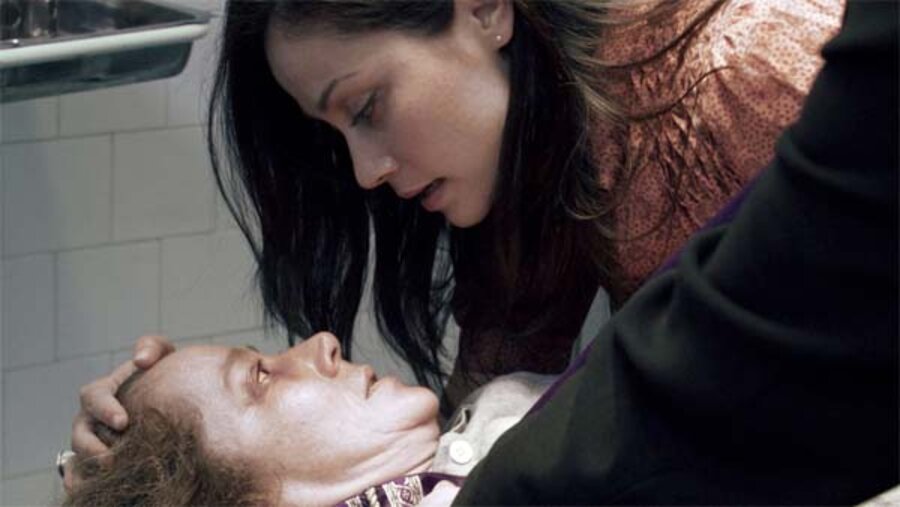'The Devil Inside' intrigues, but ultimately isn't worth it
Loading...
The Devil Inside is presented as assembled found footage that follows twenty-something Isabella Rossi (Fernanda Andrade) as she reunites with her mother, Maria Rossi (Suzan Crowley), and searches for an exorcist that can free Maria of a long-running demon possession. Maria has been locked away in a Catholic psychiatric ward, following an attempted exorcism that resulted in the murder of three people 20 years prior.
However, as Isabella spends more time with Maria in the ward, strange occurrences begin to escalate as a dormant evil finds a convenient batch of new visitors to terrorize.
Some moviegoers will no doubt be ready to compare The Devil Inside to the 2010 film The Last Exorcism – since the film also features unique locales, documentary-style filmmaking, body-contorting horror sequences, and a weighty religious side-arc. In addition, The Devil Inside also relies on a similarly grounded tone – with a lot of exposition to fill out the story. Instead of the limited (horror in a box) scope and slow-burn pacing of the Paranormal Activity series, The Devil Inside employs larger sequences that feature characters rushing from room to room to uncover a mystery, or run for their lives. While the marketing might lead moviegoers to believe that the majority of the film takes place inside the Catholic psych ward, the film actually covers a surprising amount of Italian locales, while the exorcists’ “scientific” approach to freeing people of demon possession offers some fresh ideas – not to mention smart suspense cues.
The exorcisms in the film deliver some intriguing moments, but while there are definitely a number of jump scares throughout The Devil Inside, overall the “scariest” points tend to be less “frightening” and rely on expectation and tension more than in-your-face frights. The possibility of something terrible happening fuels most of the film’s best sequences – though, looking back, some horror fans may feel as though not a lot actually happens by the end of the various proceedings.
For better or for worse (depending on how much character drama a filmgoer wants in their found footage films), The Devil Inside spends a lot of time developing the primary characters – especially how the two main exorcists in the film feel about the Catholic church. David (Evan Helmuth) is a “company man” who, despite his frustrations with pastoral politics, believes in the church and identifies strongly with Catholic doctrine. Ben (Simon Quarterman), on the other hand, is the nephew of an accomplished exorcist – and feels that working outside of the church is the only way to truly help victims afflicted by demon possession. Along with the primary narrative arc involving Isabella, the movie spends a lot of time developing these side stories – all for very little payoff. As events unfold, The Devil Inside completely abandons character building and resolution in favor of “shocking” set pieces. One Ben-centric story bit is especially under served – even though it’s hinted at more than once. The result is an uneven narrative experience that’s front-loaded with too much exposition and ends without any real payoff for the mythos (or the characters). Similarly, audience members will probably find the film’s conclusion extremely abrupt or possibly outright infuriating – at least if they are hoping for an interesting (or exciting) climactic resolution.
That said, the most outright bizarre aspect of the film is the way that the “documentary” is actually presented onscreen. A number of segments feature hand-held camera work, via cameraman Michael (Ionut Grama), coupled with static security-like footage. However, on more than one occasion following close-up hand-held camera footage (i.e., Michael in the room filming), The Devil Inside cuts to one of the static shots ( where Isabella and Rosa are the only ones in the room, for example). While some moviegoers will no doubt consider this nitpicking, the success of “found footage” films is in their ability to (for a brief moment) attempt to trick the audience into believing that these things actually happened. As a result, anyone who is invested in how the film is being presented will likely be pulled out – due to the inconsistent strategies in presenting the footage.
The Devil Inside won’t break any new ground in the “found footage” horror genre, but it does offer some intriguing ideas about exorcism, a pair of interesting characters, and a number of tense (though not entirely frightening) moments. Overall, fans of the genre are likely to enjoy elements of the film – though, given the slow, exposition-heavy opening act and a TOTAL lack of any ending or closure, many moviegoers will leave the theater feeling as though the experience wasn’t worth the ticket money.
Ben Kendrick blogs at Screen Rant.





